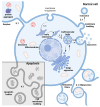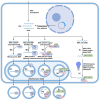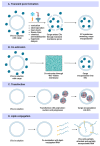Basic Guide for Approaching Drug Delivery with Extracellular Vesicles
- PMID: 39408730
- PMCID: PMC11476574
- DOI: 10.3390/ijms251910401
Basic Guide for Approaching Drug Delivery with Extracellular Vesicles
Abstract
Extracellular vesicles (EVs) are natural carriers of biomolecules that play a crucial role in cell-to-cell communication and tissue homeostasis under normal and pathological conditions, including inflammatory diseases and cancer. Since the discovery of the pro-regenerative and immune-modulating properties of EVs, EV-based therapeutics have entered clinical trials for conditions such as myocardial infarction and autoimmune diseases, among others. Due to their unique advantages-such as superior bioavailability, substantial packaging capacity, and the ability to traverse biological barriers-EVs are regarded as a promising platform for targeted drug delivery. However, achieving a sufficient accumulation of therapeutic agents at the target site necessitates a larger quantity of EVs per dose compared to using EVs as standalone drugs. This challenge can be addressed by administering larger doses of EVs, increasing the drug dosage per administration, or enhancing the selective accumulation of EVs at target cells. In this review, we will discuss methods to improve the isolation and purification of EVs, approaches to enhance cargo packaging-including proteins, RNAs, and small-molecule drugs-and technologies for displaying targeting ligands on the surface of EVs to facilitate improved targeting. Ultimately, this guide can be applied to the development of novel classes of EV-based therapeutics and to overcoming existing technological challenges.
Keywords: nanotherapeutics; surface display; targeted drug delivery.
Conflict of interest statement
The authors declare no conflicts of interest.
Figures







Similar articles
-
Extracellular vesicles for drug delivery.Adv Drug Deliv Rev. 2016 Nov 15;106(Pt A):148-156. doi: 10.1016/j.addr.2016.02.006. Epub 2016 Feb 27. Adv Drug Deliv Rev. 2016. PMID: 26928656 Review.
-
Extracellular Vesicles as Drug Delivery Vehicles to the Central Nervous System.J Neuroimmune Pharmacol. 2020 Sep;15(3):443-458. doi: 10.1007/s11481-019-09875-w. Epub 2019 Sep 4. J Neuroimmune Pharmacol. 2020. PMID: 31485884 Review.
-
Factors Affecting Extracellular Vesicles Based Drug Delivery Systems.Molecules. 2021 Mar 11;26(6):1544. doi: 10.3390/molecules26061544. Molecules. 2021. PMID: 33799765 Free PMC article. Review.
-
Strategies for the use of Extracellular Vesicles for the Delivery of Therapeutics.J Neuroimmune Pharmacol. 2020 Sep;15(3):422-442. doi: 10.1007/s11481-019-09873-y. Epub 2019 Aug 27. J Neuroimmune Pharmacol. 2020. PMID: 31456107 Free PMC article. Review.
-
Methods for loading therapeutics into extracellular vesicles and generating extracellular vesicles mimetic-nanovesicles.Methods. 2020 May 1;177:103-113. doi: 10.1016/j.ymeth.2020.01.001. Epub 2020 Jan 7. Methods. 2020. PMID: 31917274 Review.
Cited by
-
Therapeutic Potential of Extracellular Vesicles in Oral Inflammation.Int J Mol Sci. 2025 Mar 26;26(7):3031. doi: 10.3390/ijms26073031. Int J Mol Sci. 2025. PMID: 40243684 Free PMC article. Review.
-
Extracellular vesicles as vital players in drug delivery: a focus on clinical disease treatment.Front Bioeng Biotechnol. 2025 May 14;13:1600227. doi: 10.3389/fbioe.2025.1600227. eCollection 2025. Front Bioeng Biotechnol. 2025. PMID: 40438295 Free PMC article. Review.
-
Engineering Exosomes for CNS Disorders: Advances, Challenges, and Therapeutic Potential.Int J Mol Sci. 2025 Mar 28;26(7):3137. doi: 10.3390/ijms26073137. Int J Mol Sci. 2025. PMID: 40243901 Free PMC article. Review.
-
Methods and Challenges in Purifying Drug-Loaded Extracellular Vesicles.J Extracell Vesicles. 2025 Jun;14(6):e70097. doi: 10.1002/jev2.70097. J Extracell Vesicles. 2025. PMID: 40527729 Free PMC article. Review.
-
Stem-Cell Derived Exosomal microRNAs as Biomarkers and Therapeutics for Pediatric Cardiovascular Disease.Curr Treat Options Cardiovasc Med. 2025;27(1):32. doi: 10.1007/s11936-025-01088-0. Epub 2025 Apr 9. Curr Treat Options Cardiovasc Med. 2025. PMID: 40224357 Free PMC article. Review.
References
-
- Welsh J.A., Goberdhan D.C.I., O’Driscoll L., Buzas E.I., Blenkiron C., Bussolati B., Cai H., Di Vizio D., Driedonks T.A.P., Erdbrügger U. Minimal information for studies of extracellular vesicles (MISEV2023): From basic to advanced approaches. J. Extracell. Vesicles. 2024;13:e12404. doi: 10.1002/jev2.12404. - DOI - PMC - PubMed
Publication types
MeSH terms
Grants and funding
LinkOut - more resources
Full Text Sources

